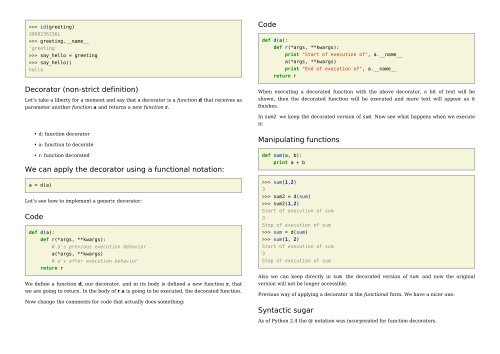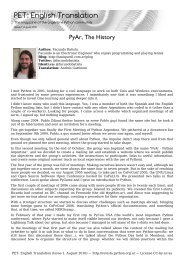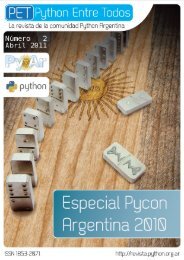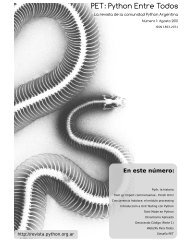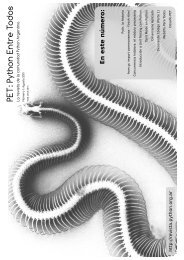color version - PET: Python Entre Todos - Python Argentina
color version - PET: Python Entre Todos - Python Argentina
color version - PET: Python Entre Todos - Python Argentina
You also want an ePaper? Increase the reach of your titles
YUMPU automatically turns print PDFs into web optimized ePapers that Google loves.
id(greeting)<br />
3068236156L<br />
>>> greeting.__name__<br />
'greeting'<br />
>>> say_hello = greeting<br />
>>> say_hello()<br />
hello<br />
Decorator (non-strict definition)<br />
Let’s take a liberty for a moment and say that a decorator is a function d that receives as<br />
parameter another function a and returns a new function r.<br />
Code<br />
def d(a):<br />
def r(*args, **kwargs):<br />
print "Start of execution of", a.__name__<br />
a(*args, **kwargs)<br />
print "End of execution of", a.__name__<br />
return r<br />
When executing a decorated function with the above decorator, a bit of text will be<br />
shown, then the decorated function will be executed and more text will appear as it<br />
finishes.<br />
In sum2 we keep the decorated <strong>version</strong> of sum. Now see what happens when we execute<br />
it:<br />
• d: function decorator<br />
• a: function to decorate<br />
• r: function decorated<br />
We can apply the decorator using a functional notation:<br />
a = d(a)<br />
Let’s see how to implement a generic decorator:<br />
Code<br />
def d(a):<br />
def r(*args, **kwargs):<br />
# a's previous execution behavior<br />
a(*args, **kwargs)<br />
# a's after execution behavior<br />
return r<br />
We define a function d, our decorator, and in its body is defined a new function r, that<br />
we are going to return. In the body of r a is going to be executed, the decorated function.<br />
Now change the comments for code that actually does something:<br />
Manipulating functions<br />
def sum(a, b):<br />
print a + b<br />
>>> sum(1,2)<br />
3<br />
>>> sum2 = d(sum)<br />
>>> sum2(1,2)<br />
Start of execution of sum<br />
3<br />
Stop of execution of sum<br />
>>> sum = d(sum)<br />
>>> sum(1, 2)<br />
Start of execution of sum<br />
3<br />
Stop of execution of sum<br />
Also we can keep directly in sum the decorated <strong>version</strong> of sum and now the original<br />
<strong>version</strong> will not be longer accessible.<br />
Previous way of applying a decorator is the functional form. We have a nicer one:<br />
Syntactic sugar<br />
As of <strong>Python</strong> 2.4 the @ notation was incorporated for function decorators.


